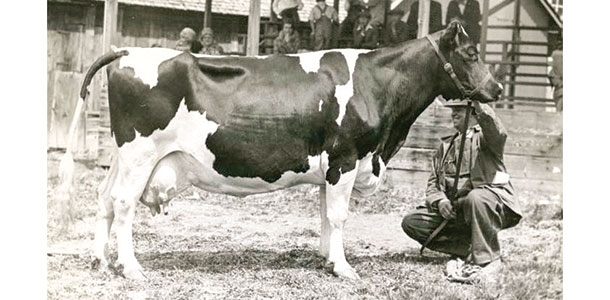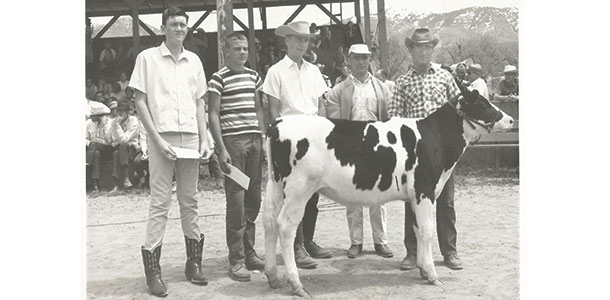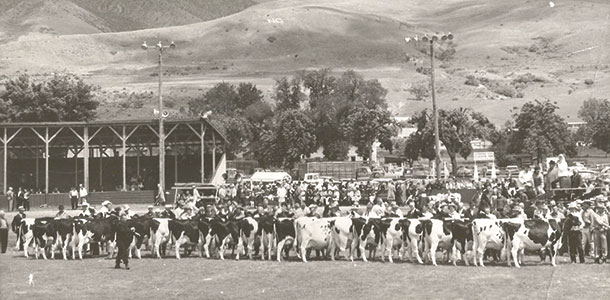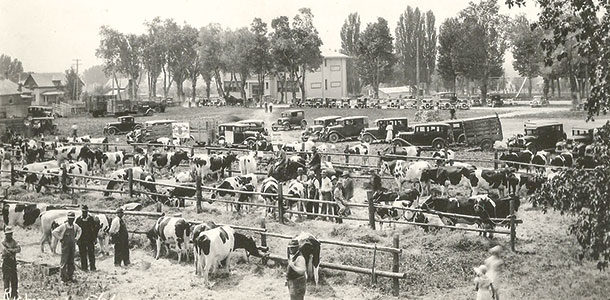Craig Harris says his great-grandpa and a bunch of his buddies were probably just sitting around one day doing what dairymen do – talking about cows – when the idea for Richmond Black & White Days was born.
Harris figures one of them said something like, “Let’s get everyone together and show what we’ve got,” and his great-grandfather, C.Z. Harris said, “Hey, we can do it over at my place.” The rest, as the saying goes, is history.
“It just sort of snowballed from there,” Harris says of what’s become an annual celebration in Richmond, Utah. The first one was held on the Harris farm in 1912. A nationwide outbreak of hoof-and-mouth disease forced a three-year break.
By 1915, the show was back in business and hasn’t stopped. Next month, the sixth generation of the Harris family will participate in the arena, just a few blocks away from the family farm.
The dairy show has also become known as the Western National Spring Show and provides participants a chance to create buzz about their Holsteins in front of top-ranked judges and buyers from all over the western U.S. and Canada.
Gilbert Teixeira has been making the 14-hour drive between his farm in Turlock, California, and Richmond for the last 15 years. While he says other shows might be bigger, the service at Black & White is worth the drive.
“They’re good about hosting. It’s nice country, and they provide a lot of hospitality,” he says.
For Teixeira, the show offers good marketability for his animals and gives the exposure they need to head to the national show in good standing.

Richmond, Utah, is a town of 2,500, about 20 minutes north of Logan in an area of northern Utah known as Cache Valley. It’s nestled amid rolling hills and is a town very proud of its rural and agriculture heritage.
The show itself has grown from a one-day exhibition to a five-day festival. This year, in honor of the centennial celebration, Harris says organizers rounded up a $10,000 prize for the grand champion cow. The typical prize is about $1,000, he says. He says he’s hoping the extra prize money this year will attract more top-quality cattle from around the West.
He says they usually have 150 to 175 show animals, but there were more than 300 animals showing in his grandfather’s time.
One of the qualities that sets this show apart is tradition. While each year, Harris says, there are new cows and new buyers from all over North America, many of the farms have been represented at Black & White for decades.
The Papageorge family of Ogden, Utah, has been participating for more than 70 years, Ted Papageorge says.
“It’s the one everybody likes the most,” he says. “It’s the most fun, and it’s a tradition. It’s funny how we go to the middle of nowhere to have a show.”
Papageorge says the best part is just trying to beat the next competitor. He and his family have had a grand champion 10 times and have been named a premier breeder of the show 18 times.
“It’s almost more of an addiction,” he says. “Just trying to stay competitive.”
He says he enjoys getting to see other people’s genetics and letting people see his.
 “They have a great sale there. This year’s going to be kind of a big deal,” he says, noting the $10,000 grand prize. “That cow’s going to be a $100,000 to $200,000 cow.”
“They have a great sale there. This year’s going to be kind of a big deal,” he says, noting the $10,000 grand prize. “That cow’s going to be a $100,000 to $200,000 cow.”
Terry Spackman and his family have also participated in Black & White Days the bulk of its history.
He says that while the event started out as a community celebration, as time has passed and agriculture evolved, it’s become a regional event.
“Anymore, there’s very little dairy business in Richmond itself,” he says. But in the valley there are processors and other dairy-based businesses that support the event, Spackman says.
“It’s a huge dairy show, and it’s known all over the Holstein world. It’s the longest continuously running show west of the Mississippi,” Spackman says.
He’s personally been involved since the early 1970s and his days in 4-H and FFA. He says it’s always been a family-oriented event. Although the show itself has become more of a professional show, if you look in the stands you’ll see large groups of families with at least two generations, and often more, represented.
“It’s just a real quality time for families to get together, and some have been at it for a lot of years,” Spackman says. “They block out the third week in May, and nothing else interferes.”
Spackman, a Richmond dairy farmer, says his family has also been involved in the draft horse pulling contests and shows that are also part of the Black & White Days event.

He says the horse show and dairy show are both usually the first of their kind in the region each season. Exhibitors will come to Richmond if they’re showing a new animal just to see how it compares to others.
“That gauges what they’ll do for the rest of the summer,” he says.
As for Harris, who has followed in his great-grandfather’s footsteps to chair this year’s show, he is very aware of the tradition he’s a part of.
“I think about it every day,” he says. “I’d give anything for my great-grandfather, grandfather and my dad to be here.”
One hundred years later, the event that started on the Harris farm with a group of men comparing cattle may look a little different, but the elements of community family and farming haven’t.
Black & White’s week-long celebration also includes a melodrama, fun run and chuck wagon breakfast. The city’s website lists the schedule of events and contact names for getting involved as an exhibitor or vendor. Plan your participation at the website.PD
Click here for Black & White Days’ 2015 schedule.
Karma Metzler Fitzgerald is a freelance writer and dairy producer in Shoshone, Idaho.
PHOTOS
One of the qualities that sets Richmond’s Black & White Show apart is tradition. While each year there are new cows and new buyers from all over North America, many of the participating farms have been represented at the annual show for decades. Photos courtesy of Black & White Days.





